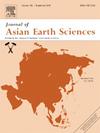Provenance of Neoarchaean metagreywackes on the western margin of the Western Dharwar Craton, South India: Implications for Madagascar − Western Dharwar Craton connection
IF 2.7
3区 地球科学
Q2 GEOSCIENCES, MULTIDISCIPLINARY
引用次数: 0
Abstract
Neoarchaean, low-grade metamorphic greywackes of the Ranibennur Formation of Chitradurga Group of Dharwar Supergroup, from the Western Dharwar Craton (WDC) were studied to understand their provenance. The metagreywackes consist of detrital quartz, feldspar and volcanic and plutonic lithic fragments in a chlorite-sericite-dominated matrix. They have low to moderate chemical indices of alteration (CIA) (50 to 60.4). The metagreywackes are characterized by fractionated light rare earth element (LREE) and moderately fractionated heavy rare earth element (HREE) patterns (GdN/YbN 1.0–3.97) and negative Eu/Eu* anomaly (∼0.79). The detrital zircon ages indicate an overwhelming contribution from 2.56 − 2.57 Ga and 2.67–2.68 Ga sources. Integration of their petrographic and geochemical characteristics suggests a provenance composed of a mix of recycled and arc-derived sediments. A four component mixing model indicated ∼55 % of tonalitic-trondhjemitic to granodioritic; 17 to 20 % of granitic, 20–22 % mafic volcanic and 3–5 % ultramafic rocks constituted the provenance composition. The rarity of igneous 2.67–2.68 Ga source rocks in the Dharwar Craton and the presence of such rocks in the eastern part of Madagascar suggest that the detrital zircon grains of that age were mainly derived from eastern Madagascar. This would imply that eastern Madagascar was part of the Dharwar Craton.
南印度西达尔瓦克拉通西缘新太古代元砾岩的物源:对马达加斯加—西达尔瓦克拉通连接的启示
研究了西达沃克拉通(WDC)达沃超群Chitradurga群Ranibennur组新太古代低品位变质灰岩的物源。偏长辉砾岩由碎屑石英、长石、火山和深部岩屑组成,基质以绿泥石-绢云母为主。它们具有中低的蚀变指数(CIA)(50 ~ 60.4)。偏辉钼矿具有轻稀土分馏(LREE)和重稀土分馏(HREE)模式(GdN/YbN 1.0 ~ 3.97)和负Eu/Eu*异常(~ 0.79)的特征。碎屑锆石年龄主要来自2.56 ~ 2.57 Ga和2.67 ~ 2.68 Ga。其岩石学和地球化学特征综合表明,物源由再循环沉积和弧源沉积混合组成。四组分混合模型表明~ 55%的调性-花岗闪长岩;物源组成中花岗岩占17 ~ 20%,基性火山岩占20 ~ 22%,超基性岩占3 ~ 5%。Dharwar克拉通中2.67-2.68 Ga火成岩烃源岩的罕见性和马达加斯加东部地区火成岩烃源岩的存在表明,该年龄的碎屑锆石颗粒主要来自马达加斯加东部。这意味着马达加斯加东部是达瓦尔克拉通的一部分。
本文章由计算机程序翻译,如有差异,请以英文原文为准。
求助全文
约1分钟内获得全文
求助全文
来源期刊

Journal of Asian Earth Sciences
地学-地球科学综合
CiteScore
5.90
自引率
10.00%
发文量
324
审稿时长
71 days
期刊介绍:
Journal of Asian Earth Sciences has an open access mirror journal Journal of Asian Earth Sciences: X, sharing the same aims and scope, editorial team, submission system and rigorous peer review.
The Journal of Asian Earth Sciences is an international interdisciplinary journal devoted to all aspects of research related to the solid Earth Sciences of Asia. The Journal publishes high quality, peer-reviewed scientific papers on the regional geology, tectonics, geochemistry and geophysics of Asia. It will be devoted primarily to research papers but short communications relating to new developments of broad interest, reviews and book reviews will also be included. Papers must have international appeal and should present work of more than local significance.
The scope includes deep processes of the Asian continent and its adjacent oceans; seismology and earthquakes; orogeny, magmatism, metamorphism and volcanism; growth, deformation and destruction of the Asian crust; crust-mantle interaction; evolution of life (early life, biostratigraphy, biogeography and mass-extinction); fluids, fluxes and reservoirs of mineral and energy resources; surface processes (weathering, erosion, transport and deposition of sediments) and resulting geomorphology; and the response of the Earth to global climate change as viewed within the Asian continent and surrounding oceans.
 求助内容:
求助内容: 应助结果提醒方式:
应助结果提醒方式:


